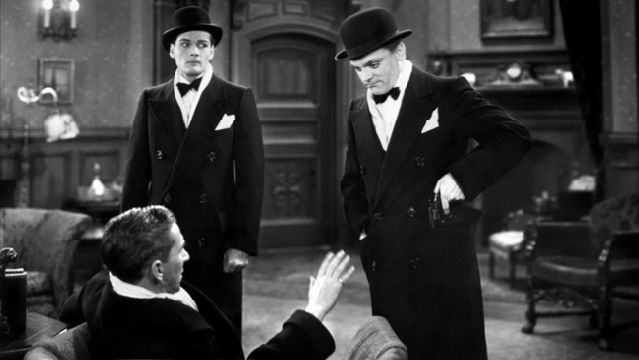The Public Enemy (1931) 

Director: William Wellman
Cast: James Cagney, Jean Harlow, Edward Woods
Synopsis: A young hoodlum rises up through the ranks of the Chicago underworld, even as a gangster’s accidental death threatens to spark a bloody mob war.
Richly deserving of its place within the triumvirate of classic early-talkie gangster flicks — the other two members are, of course, Little Caesar and Scarface (1932) — The Public Enemy, William Wellman’s razor sharp depiction of the rise and fall of a career criminal, shows just how precarious a journey it can be for a bona fide classic to make it on to the screen in the form for which it is now revered. Wellman had to persuade production chief Darryl Zanuck to make the picture after the Warners’ golden boy balked at making another gangster movie so soon after Little Caesar, only finally bringing him around by promising to deliver the toughest gangster movie he’d ever seen. Then the studio almost committed a major blunder by casting the insipid Edward Woods (They Never Come Back) in the lead role, with an up-and-coming James Cagney (The Roaring Twenties, Come Fill the Cup) slated to play his sidekick. Thankfully, Wellman or Zanuck or screenwriters Kubec Glasmon and John Bright (accounts differ) saw the light shortly before the cameras were due to roll, and the parts were switched, finally enabling Wellman to make good on his promise to his boss. The Public Enemy still packs quite a punch more than eighty years after its initial release, and it records the spectacular emergence of a major Hollywood legend who, according to many (including Martin Scorsese) introduced the era of modern acting with his mercurial performance and machine-gun delivery.
Tom Powers (Cagney) and Matt Doyle (Woods) are a couple of kids growing up in the slums of Chicago in the early years of the 20th Century, and the film’s episodic structure in this opening act charts the duo’s education, and eventual graduation, into a life of crime. From petty mischief and theft of roller skates, the friends move up to the attempted robbery of a fur warehouse, where another of their friends is shot dead by a pursuing cop and they learn just how treacherous a supposed partner in crime can be when the heat is on. The introduction of prohibition provides a breeding ground for organised crime as gangsters waste no time in meeting the widespread illicit demand for outlawed booze. Under the fatherly guidance of mob boss Paddy Ryan (Robert Emmett O’Connor — A Night at the Opera, Sunset Blvd.), the boys become involved in the lucrative bootlegging racket and see their fortunes rapidly rise. However, success brings with it powerful enemies, and when Ryan’s comrade Nails Nathan (Leslie Fenton) dies in a horse riding accident Schemer Burns and his gang start muscling in on Ryan’s operation…
The Public Enemy is inarguably James Cagney’s movie. He commands every scene he’s in. A buzzing, high-voltage bundle of energy striding around on the balls of his feet, he delivers his lines at a blistering pace and nails those opposing him with that intense and steely gaze from beneath a heavy brow that shades the cunning intelligence in his eyes. Even when he stands in the background, observing the interaction of others, he draws us to him simply because we fear that if we look away, if we take our eyes off him for an instant, we will surely miss a moment of unpredictable brilliance. There never was another star like Cagney, and by the time he reached his forties he was never again the way he was here.
He’s aided by some sublime direction from William Wellman, whose skill behind the camera compensates in part for some unremarkable performances from Cagney’s supporting cast. As Powers’ mild-mannered sidekick, Woods struggles to make any kind of impression, while O’Connor’s performance suggests just why he was soon relegated to mainly bit parts for most of his career. Jean Harlow, who plays the kind of young woman who represents to Powers the kind of privilege to which he aspires, looks just like a working-class hood’s idea of class, but her performance is uneven at best, and falls far short of the kind of performances she would deliver later in her career. If only she’d possessed the acting talent of Joan Blondell, who is under-used as Doyle’s love interest, or Blondell had possessed Harlow’s bombshell looks.
The Public Enemy was made and released pre-Code, and subsequent re-releases in the late 1930s and 40s would see puritanical censors going to work on a number of scenes. It’s noticeable, though, that despite its violent reputation, most of the killings take place off-screen, and most of the cuts made by the censors were due to sexual content — namely an overtly gay tailor taking Powers’ inside leg measurement, and an ageing moll taking sexual advantage of Powers while he’s in a drunken stupor. When it came to the violence in The Public Enemy, Wellman seemed to have a sixth sense about how best to film a scene in order for it to have the biggest impact possible. The camera even remains outside the bar in which the gunfight that marks the end of Powers’ life of crime takes place, leaving the anguished screams of the wounded as Powers staggers outside to allow the audience’s imagination to create a far bloodier scenario than his camera ever could have shown.
(Reviewed 3rd July 2014)
httpv://www.youtube.com/watch?v=r2hDKOhS7KM
